Caterpillars make great pets, both for children and for adults. Butterflies are also terrific pets as long as their special needs regarding flying space and food are met.
Taking care of caterpillars
Housing caterpillars
An enclosure for caterpillars can be really simple; it just needs to be big enough, ventilated, escape proof and safe. The enclosure should allow all caterpillars to have around 3 times their bodysize in extra floor space. A plastic box for 10 caterpillars of 6 cm in lenght should have around 25 x 25 cm floorspace. Every caterpillar should be able to feed without having to touch other caterpillars.
A lid with proper ventilation will make the enclosure escape proof. Often caterpillars do not move a lot, except for searching for food or searching for a place to pupate.
A safe enclosure does not contain any sharp edges or objects where the caterpillar can get stuck under.
The enclosure does not need any decoration, because it will be filled with the food plants of your caterpillar. On the floor of the tank you can place tissue paper to absorb any water or droppings.

An Euthrix potatoria caterpillar
Feeding your caterpillars
Caterpillars eat a lot. Feeding them enough of appropriate fresh food plants is essential for their health and growth. Caterpillars eat one or more different kinds of leaves. When a species eats different species of trees or bushes, it is good to offer several of these species to ensure a diverse menu.
When the caterpillars are small and do not eat a lot, you can feed them either by offering their food plants in a glass of water or by just placing the leaves on the floor of the enclosure. When you put the leaves in a glass of water, like cut flowers, the leaves stay fresh for a long time (around one week). When you place them on the floor, they need to be replaced often because they will dry and become uneatable. Caterpillars only eat fresh leaves that have enough water.
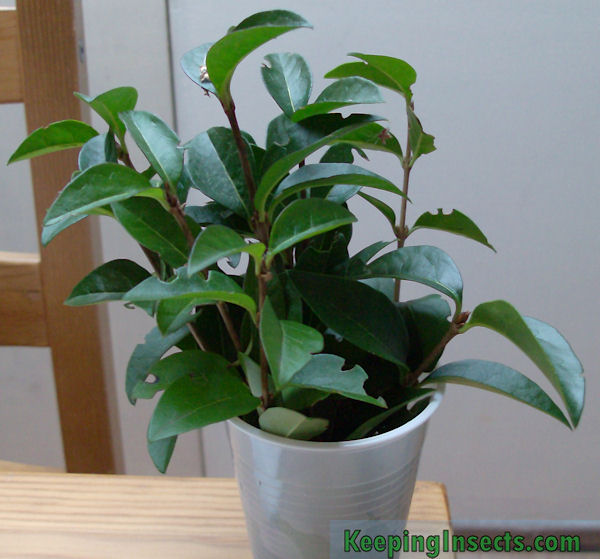
You can offer leaves in a cup, in this way the leaves stay fresh for a longer time. This is privet
Keeping the environment suitable for your caterpillars
Caterpillars require some moisture to keep their skin moist and to drink. Not all species need the same amount, how much a given species needs can be read at the caresheet of this species. The best way to supply water to your caterpillars is by washing the leaves you give to them with clean water. The droplets that stay on the leaves will give the caterpillars their necessary moisture.
The temperature at which you keep your caterpillars will determine their health and growth speed. Every species has its own specific temperature in which it will thrive. Keeping caterpillars at a lower temperature than their optimal temperature will reduce their growth speed a lot and can be detrimental to their health.
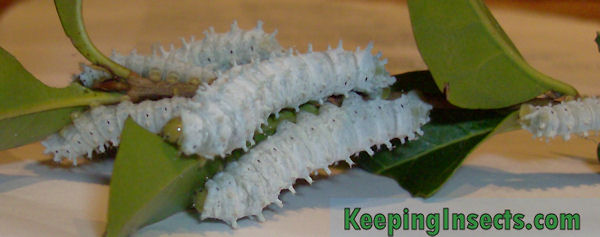
Samia cynthia caterpillars eating privet
Cleaning
You need to clean the tank of your caterpillars every day. Caterpillars produce a lot of dropping which, in combination with moisture, can host mold and bacteria. When you use paper tissues at the bottom of the enclosure, you can just remove this paper and replace it with fresh paper. This will take only a few minutes.
When cleaning the enclosure you also need to remove any old leaves and stalks of the leaves.
Getting the pupae out
When the caterpillars reach their last stage of development, they will try to find a suitable place for pupating. A butterfly pupa is called a chrysalis. The caterpillars will generally move around a lot and try to find a good spot to make its cocoon. When you see this behavior, make sure you have enough space available for all caterpillars to pupate at. If the current enclosure is not suitable, transfer all caterpillars that are ready to pupate to a more suitable enclosure. When you find a cocoon, carefully remove it from the place where you found it and place it in a separate enclosure (without any caterpillars). Keep this enclosure rather dry, but not completely without humidity. You can lightly mist the substrate at the bottom of the enclosure (e.g. tissue paper).
Taking care of butterfly pupae
A pupa is the actual stage between caterpillar and butterfly, its also called a chrysalis. A cocoon is the silky stuff the caterpillar produces to wrap itself in, and to protect the pupa. Not all butterfly and moth species make cocoons, but all species have the chrysalis stage.
The best way to take care of cocoons is to hang them on a string or something similar. You could also jut place the cocoons on the floor, but this will often give problems when the butterfly wants to get out of the cocoon.
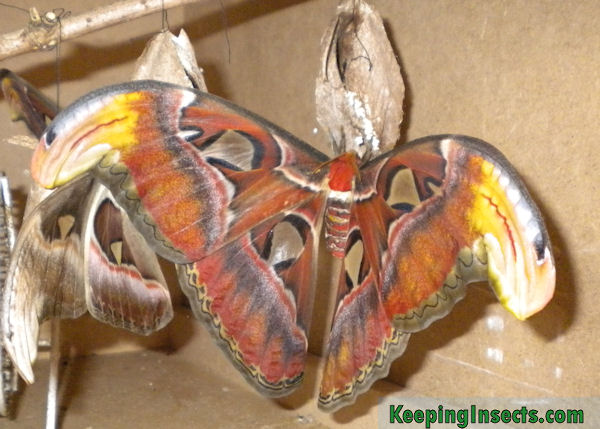
This female Atlas Moth just got out of her cocoon. You can see a bit of how I hung the cocoons.
Hanging the cocoons
The enclosure where you will hang the cocoons in should be at least twice as big as the wingspan of a butterfly in all directions from the pupa. To hang the cocoons, use a needle and thread to put a bit of thread through the pointed end of the cocoon. Make sure not to touch the pupa inside! You can hang the cocoon from the thread. You can also use a pin to hang the cocoon. Hang the pupae on a wooden stick or something where a butterfly can get a hold of (so no metal or plastic). All the sides of this enclosure should be made of mesh or fabric to ensure that the butterfly can walk up on the walls if it happens to drop to the ground.
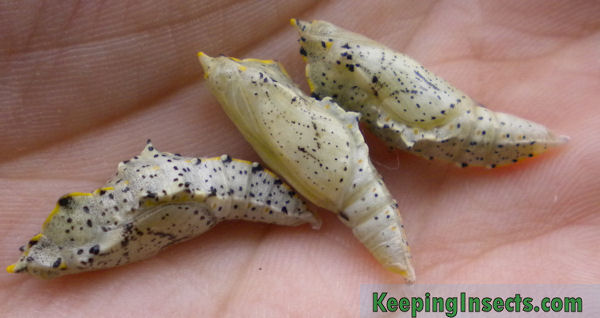
The pupae of these butterflies are not covered in a cocoon. You cannot easily hang them on a thread because it can harm the pupae.
Environment and care for chrysalises / cocoons
Butterflies stay between around 8 days to some months in their chrysalis stage. Make sure the temperature and humidity are suitable for your species of butterfly. This is different for all species, so check out our species list to see what your species needs.
Taking care of butterflies
When you get butterflies out of your pupae, you can choose one of two things; release the butterflies in nature or keep them as pets. You can only release species of butterfly that are native to your country. When you want to keep butterflies, you have to meet the needs of this beautiful flying creature in temperature, food and space.
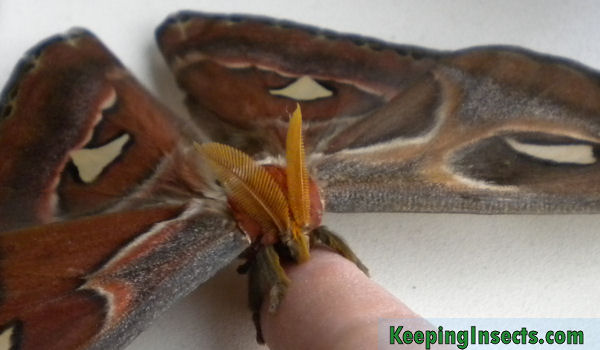
An Atlas moth on my finger.
Enclosure for butterflies
For butterflies, every enclosure is too small. Therefore, make sure you have the biggest enclosure you can accommodate or afford. Species that are not able to fly need less space than flying species.
The enclosure should not consist of glass or plastic, because the butterflies cannot walk on this and will continually flap against the glass. An enclosure made of mesh or mosquito netting is more suitable. Some people let their butterflies fly around in a room of their house. When the room is safe for the butterflies, this is a great way to keep them.
Keep in mind that butterflies need and want to fly. This means they will try to fly against the enclosure, sometimes excessively. This will harm their wings.
Feeding your butterflies
Some species of butterflies do not eat at all. Only the caterpillars eat, while the butterflies itself have no mouth! These species are common in captivity, because they are easy to keep.
Species that do feed as adults, need nectar or a sugary solution to drink from. Nectar can be given by offering fresh flowers of the species that the butterfly visits in nature. It is easier to supply a sugary solution to feed your butterfly. You can dissolve sugar or honey in water in dilution of 7 parts water and 1 part sugar. Mix this solution well and refresh it every day. You can offer the sugary solution in a cup that is covered in mosquito netting. The solution should reach to about 0,5 to 1 cm of the netting to make sure the butterflies can reach the sugary solution with their tongue.
Maintaining the proper environment
Make sure the temperature and humidity in the enclosure of your butterflies is suitable for the species that you care keeping. Especially the temperature is important. The best way to heat up butterflies is by using a light bulb. In this way the butterflies can bask in the light to heat up, or move out of the light to cool down. Make sure the butterflies cannot fly into the lamp, because this can burn and harm them.
How to breed your butterflies, can be read here.

